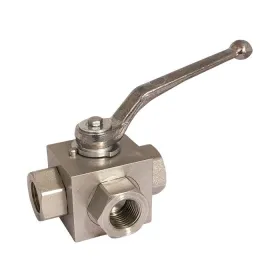
Hydraulic fittings can connect a variety of materials, including tubes, pipes or hoses to components such as pumps, valves or cylinders. When combining these components, you create a leak free system that hydraulic fluid allows for safe transmission. There’s a multitude of fitting configurations and variations to choose from. So, designers have the ability to change the direction of flow, split flows and alter the elevation of lines. Therefore, we have put together some information on how to choose your hydraulic fitting.
What Makes Each Hydraulic Fitting Unique?
There are a large variety of fittings available, including the following:
• plugs
• unions
• elbows
• crosses
The threads of the connections is what significantly differentiates these fittings. In addition, SAE, NFPA and ISO documents can also help you distinguish your standard which will help you confirm the diameter and type of thread your fitting has.
The connection of fittings is possible in the following ways:
• welding
• threaded
• flanged
• barbed
• quick disconnect
• push to connect
• 37° flare
• 24° flare
• staple lock
• face seal
• push-fit
• press fit
With a non-flanged fitting, these products will have a gender of one of the following that join together to form a union:
• male (threads on the outside)
• female (threads on the inside)

Factors to Consider When Choosing Your Hydraulic Fitting
When deciding on which type of fitting to select for your system, there a few important factors to consider. These include the following:
• working pressure
• vibration
• fitting configuration
• desired attachment
• size of piping
• flow
• material of the conductor or component you are connecting to
• pricing requirements
Equally as important is the use of a seal. The fluid power industry is slowly converting to elastomeric seals to help prevent leakage. However, depending on your application, you must ensure that your seal is compatible with the type of hydraulic fluid flowing through your system. Very few applications will require anything other than Buna Nitrile or Viton.
The majority of fitting types are available in different materials including the following:
• plastic
• brass
• copper
• steel
• stainless steel
• specialty materials
Base your material selection on the fluid flowing through your hydraulic system as well as ambient conditions. Depending on what you need for your application, each material will have different performance characteristics. Often times, the first obstacle to tackle is matching your fitting to a similar material to the conductor or component that you will connect it to.
Another important component is choosing the geometry of your fitting. Generally, the geometry fitting is the alphabet letter the fitting resembles. There are fittings that can change the direction of flow and various increments (45° or 90° elbows [L]), or a swivel that allows two jointed sections the ability to rotate. You can also find fittings that have the capability to split or combine flows with the following:
• run or branch tees (T)
• “wahys” (Y)
• crosses (+)
Hydraulic Fitting Dash Sizes
Depending on your system, you may need larger or smaller sizes to fit flow demands. The expression of fitting connection size is typically in dimensionless terms representing 1/16 of an inch.
For instance, if someone calls out a “-0.6 thread,” they man the size is 3/8 or 6/16 of an inch. A “dash 32” size is a 2-inch connection or 32/16 of an inch. Also, the thread type of the fitting will determine the connection sizes.
These are just a few important factors to determine how to choose your hydraulic fitting. Contact us here at Changsong for more information!






